Headed for Burketown on the Gulf we propped on the north flowing Gregory River at Gregory Downs, for three nights. Driving through the savannah, as with most of the country, a band of trees shows you there is a creek bed or river there. The Gregory is well indicated as you drive along but we had little idea what a fine river it is until we arrived at the Downs and turned left over the tall new bridge across the river itself. Fifteen metres or so below us a cluster of caravan roofs made it plain that good value free camping was to be had, albeit in the bed of a river that rises 15 metres in the wet, carrying all before it!
 The Gregory, named for the explorer, rises in the country just north and east of Camooweal (Camooweal’s other nearby river is the Georgina but it flows south to Lake Eyre). It’s origin is the Great Artesian Basin, and it flows constantly in the dry season, high in calcium carbonate but very drinkable and a perfect temperature for swimming. Five thousand canoe people descend on this place each year to compete, in May, the Gregory being considered one of Australia’s best rivers from that point of view. We found the perfect and remote spot beside a fast flowing stretch, with good rounded stones under foot, but grassy sandy banks too. It was heavenly. As happens, a couple pulled up and took a nearby spot on night two, but he turned out to work with a fellow we had been put in touch with in Alice Springs who is helping us find a suitable place to store the rig for a month. Five stages of separation or something. Andrew and Prue were great company and they brought with them a canoe and a telescope for bird watching and star gazing.
The Gregory, named for the explorer, rises in the country just north and east of Camooweal (Camooweal’s other nearby river is the Georgina but it flows south to Lake Eyre). It’s origin is the Great Artesian Basin, and it flows constantly in the dry season, high in calcium carbonate but very drinkable and a perfect temperature for swimming. Five thousand canoe people descend on this place each year to compete, in May, the Gregory being considered one of Australia’s best rivers from that point of view. We found the perfect and remote spot beside a fast flowing stretch, with good rounded stones under foot, but grassy sandy banks too. It was heavenly. As happens, a couple pulled up and took a nearby spot on night two, but he turned out to work with a fellow we had been put in touch with in Alice Springs who is helping us find a suitable place to store the rig for a month. Five stages of separation or something. Andrew and Prue were great company and they brought with them a canoe and a telescope for bird watching and star gazing.  The bird life was extraordinary. We have shown interest in the past, and have two pairs of bino’s and a copy of Morecombe; you couldn’t ignore the diversity of birds. Overhead, with large nests perched at the top of the Melaleucas, were two families of Whistling Kites, the adults turned lazily overhead most of the day. Occasionally some serious nest building would take place, so it seemed they were preparing for the second clutch already. A Channel-billed Cuckoo, a large bird and unconcerned by the closeness of the kites, checked out all the opportunities to the background the “Oll ee Ock” of the Peaceful Doves (pictured). Crimson Finches stepped carefully down the stiff grass stems to dip their beaks into the fast water. Looking on, the Azure Kingfisher sat above the stream casting its eye up and down. Its cousin the Blue winged Kookaburra called raucously in a kooka sort of fashion, speculating doubtless on the location of the next cane toad. Honeyeaters and flycatchers abound.
The bird life was extraordinary. We have shown interest in the past, and have two pairs of bino’s and a copy of Morecombe; you couldn’t ignore the diversity of birds. Overhead, with large nests perched at the top of the Melaleucas, were two families of Whistling Kites, the adults turned lazily overhead most of the day. Occasionally some serious nest building would take place, so it seemed they were preparing for the second clutch already. A Channel-billed Cuckoo, a large bird and unconcerned by the closeness of the kites, checked out all the opportunities to the background the “Oll ee Ock” of the Peaceful Doves (pictured). Crimson Finches stepped carefully down the stiff grass stems to dip their beaks into the fast water. Looking on, the Azure Kingfisher sat above the stream casting its eye up and down. Its cousin the Blue winged Kookaburra called raucously in a kooka sort of fashion, speculating doubtless on the location of the next cane toad. Honeyeaters and flycatchers abound.One of the joys of Gregory River at this place, and we made the most of it, is to swim in the large pool above the shallows, then let the flow catch and take you as it winds through under the overhanging pandanus, through whirlpools and over sunken logs, all the way under the bridges, about half a kilometre. To see grey nomads behaving like their grandchildren was a lovely sight to behold! A few days later, talking with the park ranger at Lawn Hill, he told us he had seen an estuarine crocodile 5 kms above this pool a couple of years ago, and duly had erected suitable signage, but the publican took the signs down before the canoeists arrived because “it doesn’t look good for business”! You can get fixated on the buggers!
To keep the batteries in reasonable shape we had to move on to Burketown, as close to the Gulf as you can get, even though it is still 25 kms from the coast itself. Settled originally to provide a port for the beef trade with Batavia in the 1860’s, it suffered through Gulf fever (probably Typhoid) and most residents died. Those who didn’t moved to Sweres Island nearby. Then, a couple of years later, the town was flattened by a cyclone. They struggled on but stock prices were so low and distances so high that the only income to be had for years was by reducing all the stock to meat and tallow. The town had been established on one of the many curling bends of the Albert, and perhaps the greatest indignity occurred when the river cut through and formed a new channel, leaving the town and its wharf five kilometers from the river. It soldiers on however, and tourism feeds the lifeblood back in, along with Barramundi. We hoped to buy some but the only way to buy is in 10 kg frozen blocks! The BarraBurger sold at the caravan park is special. The banks of the Albert are of course where old Porous hangs out, so we had to go and look. Helen stood on the bank and pointed at this place where a large three toed person had launched their boat earlier. The crocodile handbag imprints next to it gave us that strange feeling, as did the sound of young ones behind us in the long grass. Time to move on.




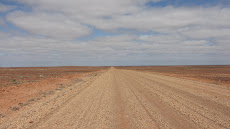
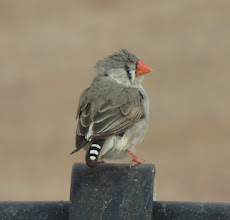
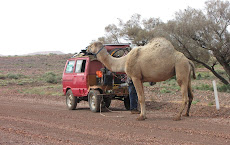
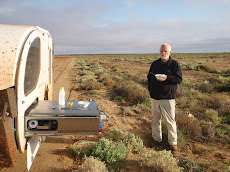
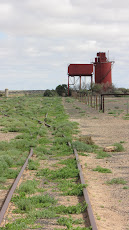
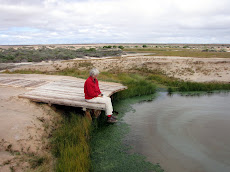
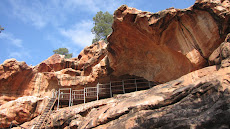



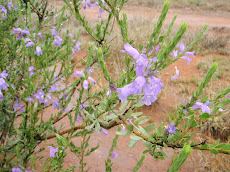







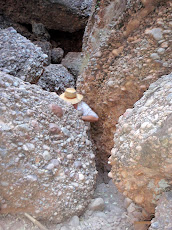







































































gorgeous!!!! wildlife absolutely stunning! what an amazing country we live in...
ReplyDelete